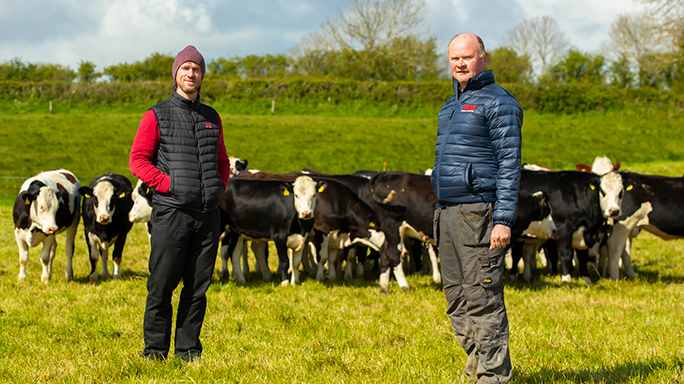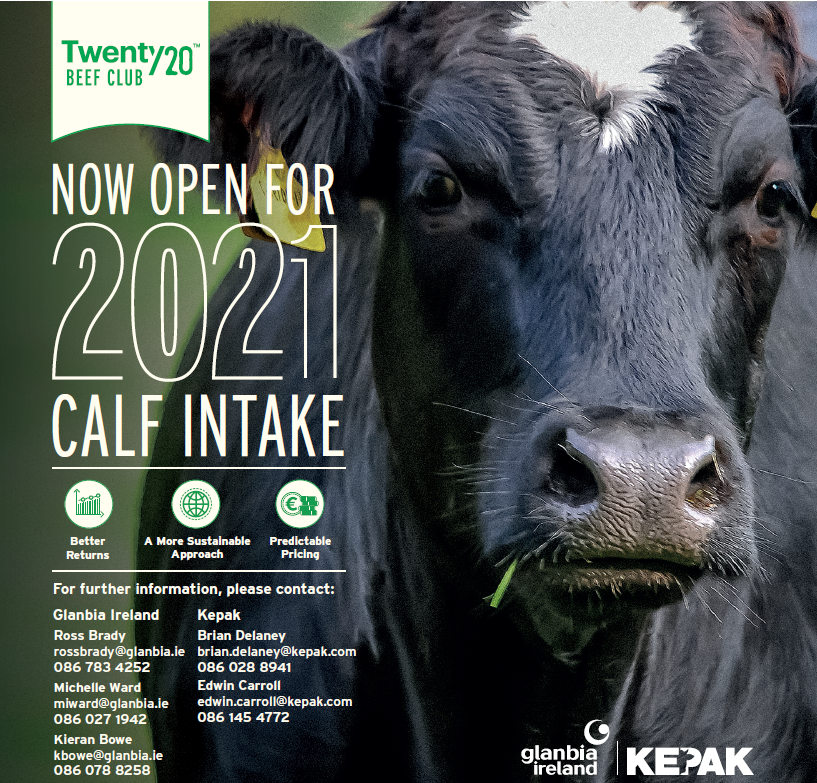Twenty20 Beef Club 'a perfect fit' for Kilkenny farmer

Joining the Twenty20 Beef Club was an obvious choice for Kilkenny. farmer Edward Delahunty. The joint Glanbia-Kepak programme fitted neatly into the mixed farming operation which Edward runs with his father, Martin, near the village of Freshford. The Delahuntys carry a combination of dairy and beef stock on the farm, as well as doing a share of tillage.
“We carry around 110 cows, and finish over 100 beef cattle each year,” Edward explains. The bulk of cattle finished to beef are bred from the dairy herd, along with some calves that are bought in from two neighbouring farmers. The Delahuntys supply winter milk to Glanbia, with around 40 cows calving down in October-November, and the remainder spring calving. The dairy herd is 80% British Friesian, with a 20% Holstein mix. “The British Friesian gives good square calves that can be easily finished to beef, as well as delivering good fertility,” Edward says. “The Holstein mix is good from a dairy perspective in that it gives you extra milk. It is also beneficial for the beef enterprise, because you get that lift in terms of size. You get a bigger frame to the animal,” he points out. While around 50 of the cows are bred to dairy sires, the remainder of the herd is put in calf to a Hereford bull.
“We always finished Hereford cattle here. That’s part of the reason I kept with the beef enterprise instead of going up in cows numbers. I just really enjoy finishing beef cattle. “However, this attachment to beef was sorely tested at the height of the COVID-19 crisis last spring when the base price dropped to €3.40/kg.
“It’s not a nice place to be, when you’re doing the job really well but there is very little margin out of it,” Edward explains. It was decision time for his beef operation. “I needed a guaranteed minimum price for the cattle. I checked around, but the answer was really close to home because the Twenty20 Beef Club programme ticked all the boxes.” Since Edward was primarily finishing his own calves, or buying calves from neighbour- ing farmers who are registered in Twenty20, plus the majority of the stock qualified for the programme. The remainder of the criteria fell into place fairly quickly.
“There’s the requirement that you have to buy your inputs from Glanbia. But I was doing that anyway, and at very competitive prices. We fed the GAIN Complete Beef Nut and the cattle did really well on it. I was very happy with the nut,” Edward says. “With the guarantee of the average base price, the various bonuses and the fact that there is a minimum price built in should markets fall, joining the Twenty20 Beef Club programme made total sense.” Animals enrolled under the Twenty20 Beef Club are eligi- ble for the average base price, plus the club premium which delivers an additional 15c/kg to 25c/kg, the Bord Bia QA bonus, a guaranteed breed bonus (for Angus and Hereford cattle), and a seasonality bonus of 6c/kg to 10c/kg. The benefit of the programme was evident from the last 15 cattle that Edward processed in Kepak. Nine of the cattle graded R, five graded O+ and one animal was O=. The cattle averaged €4.48/kg, with the R grades averaging €4.56/kg. The breakdown of the €4.56/kg for the R-grade stock is shown in Table 1.
|
Base price |
405c/kg |
|
Twenty20 Beef Club premium |
15c/kg |
|
Seasonal bonus |
6c/kg |
|
QA bonus |
20c/kg |
|
Breed bonus |
10c/kg |
|
Total |
€4.56 |
While Edward accepts that a certain level of this bonus structure is available to all beef finishers, he estimates that the payments available under the Twenty20 Beef Club delivered an average of around 22c/kg to 23c/kg.
Base prices have moved on to top €4/kg over the last two months, but he points out that the Twenty20 Beef Club premium delivered 25c/ kg close to St Patrick’s Day when the base price was under €3.75/kg. “That 25c/ kg equates to around €87 per head given that the average carcase weight of the heifers and steers supplied to Kepak was 350kg.“That was a good return for a programme that is very simple and uncomplicated. In fact, there is no real drama to it at all,” Edward maintains. “It certainly helps that the programme fits in with how we run our dairy and beef operation,” he adds. The average live weight gain from birth to finishing for both his steers and heifers came in to around 0.9kg/day. The majority of the cattle are finished out of the shed as they hit 24 months, between January and April. The environmental and economic advantages of finishing at this stage are very evident to the Delahuntys and is something the Twenty20 Technical team support the farmer in achieving. Some of the autumn calves are finished off grass in the back end of the year. How- ever, Edward says that is the exception rather than the rule. The bullocks and heifers are penned in groups of 10 according to size, and are then moved according as they come ready for the factory. “We finished 15 or 20 cattle in January, the same in February, and the same again in March and April.”
Keeping under the carcase weight limit for the Twenty20 Beef Club is one area that will need more of his attention. Edward admits: “Traditionally, my opinion on cattle weights was like Brian Cody’s view on scoreboards. The only scoreboard that mattered was the one at the end of the hurling match, and the only weight that mattered was the finishing weight. But, that approach will need to be tweaked for the Twenty20 Beef Club.”
However, close to 90% of the animals Edward supplied to Kepak Watergrasshill this year were within the club’s 280kg to 360kg weight specification that the comprehensive bonus structure incentivises.
For more information on the Twenty20 Beef Club, please contact Twenty20 Beef Club Programme Manager, Ross Brady on 086 783 4252.
First Published: 18 May 2021
